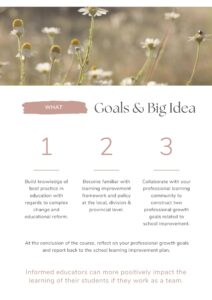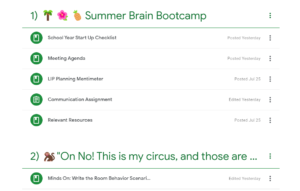Doing Better: Kelliher Staff Professional Growth Blended Course
This course is designed to promote Collective Teacher Efficacy through professional development. The aim is to empower adult learners to enact complex change and educational reform to create equitable conditions for student learning. While this course is curated to address learning opportunities at the local level, it may easily be adapted to other settings.
Throughout the course, the learner will build knowledge of best practice in education with regards to complex change and educational reform, as well as key provincial and local learning improvement frameworks. Through collaboration with a professional learning community, the learner will construct two professional growth goals applicable to their context to implement at the school and/or classroom level. At the conclusion of the course, the learner will reflect on the effect of the goals and report back to the school learning improvement plan.
Rationale
The rationale for choices made in the design of the course is ultimately to better meet the need of the learners – my amazing colleagues (who are also busy volunteers, parents, grandparents and community members). Let me tell you about these people! School employees in our school teach across a broad range of curricula and plan for predominantly triple grade splits. The school has a vulnerable designation and many students come from low SES backgrounds and suffer from trauma and opportunity gaps. There are few services available to students, so quite often the staff fill those gaps through volunteer hours. As such, staff often do not have time to positively network with staff, keep up with best practice in education or build skills required to meet the needs of increasingly complex classrooms. This results in frustration and hopelessness.
To help with this issue there needs to be a change from the practice of long monthly meetings. Instead, meetings must be purposeful, concise and flexible. The course is designed to have both synchronous and asynchronous options for participation to promote flexibility and allow staff to work on professional learning when they have time. Topics are relevant and pre-planned so that they support staff in learning together, co-constructing a path forward, as well as connecting and finding hope together. Google Classroom was chosen as the LMS due to staff familiarity with the platform with the intention that this will reduce time required for learners to access the content.
The following video goes through the intention, outcomes, and sequence of the course:

2 Minute Course Outline
Interactions and Building Community
The action is in the interaction- Douglas Conant
Promoting community is one of the most important, foundational pieces to working with my group of learners. This community must share ideas, debate understandings, agree AND disagree on professional practices, and problem solve together. In the blended course,
Learner interactions will most often have a collaborative learning focus with lots of group problem solving, learning and idea sharing. Some of the Collaborative Learning Techniques and Platforms used include:
- Jigsaw
- Think Aloud Pair Problem Solving
- Storytelling
- Project Based Learning (PLC)
- Brainstorming/Concept Mapping
- Case Studies/Comprehending for meaning (viewing, reading, listening)
- Field Trips/Service Learning
- Games
- Debate/Fishbowl/Group Discussions/Think-Pair-Share
Interaction Platforms will include, but are not limited to:
- Google Classroom
- Multimeter and Google Forms
- Kahoot
- Edsby
- Google Jamboard
- Google Docs
- Teams
- Screencastify

Thank you Kate-Lynn for showing me how to insert emojis into my titles!
Assessment Strategies and Tools
Bates’s Chapter 4.4, the Online Collaborative Learning Theory, was foundational to my decision making about assessment. He framed the idea of students working together to “create knowledge, to invent, to explore ways to innovate, and, by so doing, to seek the conceptual knowledge needed to solve problems rather than recite what they think is the right answer,” helped me to frame my intentions. This is what I want for my learners!
Due to my view of the learner, my understanding of my role and my educational philosophy, the assessment of this course will not be typical to most courses. There will be limited assessment of the learner, and increased learner assessment of the learning environment we have created for collaboration. Feedback will be collected frequently to further refine the space for optimal learning. My assessment of learners may be used towards their professional growth appraisals, but mostly the information gathered by learner participation will be utilized to further inform the direction of learning improvement in our school. Much of the assessment will be learners deciding what they have learned, what they wish to continue learning and whether they are satisfied with what they have learned.
Assessment Methods
- Monthly Formative: Feedback Loops, Surveys, Games, Anecdotal Observation, Project Work, Peer Assessment
- Yearly Summative: Professional Learning Community Reports, Teacher Professional Growth Plans, Learning Improvement Plan Goal Reporting
- Monthly Reflective: Ongoing feedback on learning environment and ongoing change to direction of course content, sequence, and method
Considerations for Common Concerns
Staff Mental Health and Well-being remains on the top of the list as a major ongoing concern in the profession. The entire course outcomes are laid out in advance to support long term scheduling. However, while the entire course outcomes are laid out in advance, half of the sessions are flexible to meet the needs of busy participant schedules and the synchronous sessions are able to be adjusted in response to the demands of the building. Learners may choose more collaborative or more individual styles of task completion as well to meet their professional growth needs.
While access to technology is not a concern due to being provided by the school division, staff must know how to utilize it effectively. Additional one-on-one or small group training is available to support staff who need help utilizing technology.
Featured Module
The highlighted module I want to focus in on is Topic 6: Silence is Acquiescence. The content within this topic explores the Inspiring Success: First Nations and Metis PreK-12 Education Policy Framework and the application of this framework to Equitable School Transformation in our local setting.
This topic can be explored synchronously (at a monthly staff meeting) or asynchronously (on the educator’s own time). There is one group activity that must be completed collaboratively, and I expect that I might have one group of commuters agree to do this activity virtually together.
The lesson starts with a self reflection where learners examine their personal and professional understanding of anti-racist and anti-oppressive education. ‘
Key terms to be explored are:
- Power
- Positionality
- Equity
The “Minds On” activity has learners score themselves on the classic privilege walk exercise, and then view my Lumi interactive video to begin the reflective process.
The next part of my lesson is a collaborative Jamboard activity where we develop group norms for professional conversations about race and inequity as they might be sensitive topics for some, depending where they are on their journey towards anti-racist and anti-oppressive education. I chose to use an adaptation of the Circle of Courage model for professional collaboration by Dr. Martin Brokenleg, as all staff will be familiar with this format because we are a Circle of Courage school. This is followed by another Jamboard called Someone on my mind… which will help staff to personalize this issue to their everyday lives through a focus on a student they care about.
As a “summative assessment”, the learners will work in groups to complete the Indigenous Education Responsibility Framework for our school (The readability will be best if you download it to view in excel). This framework has been created by the Saskatchewan School Boards Association and the Strategizing Continuum includes Observing, Supporting and Disrupting, which I think is quite progressive and a bit rebellious — and I love it!
In closing, I will have students revisit “Someone on my mind…” to add the larger systemic impacts that might be made on the student in mind and complete the exit slip to share their final thoughts on the topic.
The main resources I used for this topic’s development include:
The Listening Leader by Shane Safir (THIS IS A MUST READ!!!)

In addition, I used an old PD Resource- Leading to Learn: Impacting First Nations, Inuit and Metis Student Outcomes: Signpost 1. This was a training that was put on by Student First and the STF Professional Development Unit, therefore it is tricky to share the source. If it is ever offered again — definitely sign up!
This is a big topic, and we know it is a long road. In closing, I will share one more encouraging quote, near and dear to my heart and important to my practice:
“Do the best you can until you know better. Then, when you know better, do better.” – Maya Angelou
Complete Course Walkthrough
I used ClipChamp to make my course walkthrough video! It was extremely user friendly for webcam video, screencasting and editing. 10/10 recommend!
The final product is about 15 minutes. The first part includes the information covered above, as well as the little outcome video, so if you want the “meat and potatoes,” you can start around the 3:48 timestamp.
Complete Course Walkthrough Link
You may also choose to dive right into the class! Your organization’s email might not let you join, but if you use a regular email address, you should be able to access it using either:
The Invite Link: https://classroom.google.com/c/NTIzMTE5NjU2NDAy?cjc=ho4ikzn
Or the class code: ho4ikzn